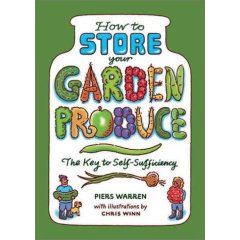I just finished another great book, How to Store Your Garden Produce by Piers Warren. This book shows you how you can eat home grown goodness all year round by preserving your garden produce. In the opening paragraphs it points out that an acre of land can provide food for a family of four for the entire year. BUT much of that produce will become ripe and available for eating at pretty much the same time (during summer), so this is where food storage comes in. If we dont find a way to store our produce for consumption at other times during the year then we find ourselves needing to make unnecessary trips to the grocery store. Food storage helps us avoid waste and develop self sufficiency.
The first half of the book provides instructions and tips for the following food preservation methods:
Freezing
Clamping
Hanging
Drying
Bottling
Pickles and Chutneys
Jams
Fermenting
The second half of the book is more of a reference section and discusses which preservation methods are applicable and preferred for the majority of fruits and veggies that we grow.
I devoured this book in short time and the illustrations by Chris Winn had me rolling on the floor laughing. I found it to be a great resource for those who want to preserve their own garden produce. The only part of the book that I felt needed more exploration was the section on clamping. It had so-so directions and no pictures and for anyone who wants to keep potatoes you must know this method of storage so a little better explanation was needed. But dont let that stop you from reading this book. I would just suggest reading up on clamping in John Seymours book A Self Sufficient Life and How to Live It. No gardener should be without that book anyway.
I especially appreciate How to Store Your Garden Produce because it shows you how you can eat local all year round. If you grow your own food and make it last all year round then there is no need to go to the supermarket and buy produce that is no doubt flown in from various other parts of the world. You dont even have to grow it yourself really. If you buy local produce at harvest time you are still able to store it for future consumption and eat local all year long.


This book looks interesting. Another good one along the same lines is and old standby, Putting Food By (Janet Greene, Ruth Hertzberg, and Beatrice Vaughan). What I can’t seem to find is a formula to help those of us new to self-sufficiency get started and decide how much of which things to plant. I’d love to find a book that says, okay, for a family of four you’re going to need X pounds of green beans, X pound of potatoes, etc. with a few tips on how to tweak the formula to fit your family’s unique needs and then information on how many plants you will need. How many pounds of tomatoes does one plant generally produce? How many pounds of beans can you get from a 20 foot row of vines or bush beans? I’d love it if someone could point me in the right direction. Perhaps I should simply resolve to find the answers and write my own book.
Laura:
Ive been a family gardener for several decades and Im still not able to accurately predict the yield on my garden. There are a lot of books to give a sort of guideline but farming is unpredictable. I use The Square Foot Gardener as a reference for how to space veggies and what to expect (approximately) as a yield. But its always been an adventure. For example: My husband dearly loves yellow crookneck squash. More than one bush floods the family with enough squash to feed a family of four, all friends who dont duck when they see us coming, the chickens and still I feel wasteful for those which end up in the compost pile. One year I decided that enough was enough and we would only plant one bush. The bush was trampled by an over zealous puppy and we were squash-less for an entire season. So, now I plant two and hope for a poor yield.
This year was a bumper crop for broccoli and green beans, but my onions were smaller than usual. I have found it pays to be adaptable; after all, that pursuit of consistency and maximum yield is what drove the commercial produce market to become what it is now. I plant what I believe will feed my family, and then wait to see what the ground gives me.
Thanks for the useful information
Thanks
Garden flags